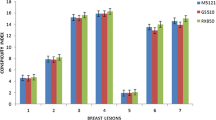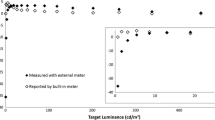Abstract
The digital imaging and communications in medicine (DICOM) standard proposed the grey-scale standard display function (GSDF) as a calibration tool for making the gradation characteristic of a radiographic output image consistent. This is designed in such a manner that the contrast visually recognised by observers (called psychophysical contrast) becomes a constant for all digital driving levels. The DICOM standard calls such an ideal characteristic perceptual linearisation. The psychophysical gradient that can express the psychophysical contrast was introduced for the evaluation of the GSDF using a liquid crystal display monitor. Investigations regarding its ability to yield a constant psychophysical contrast, independent of the digital driving level change and under an actual observation environment, such as for clinical radiographic diagnosis in hospital, were carried out. The psychophysical gradients of the GSDF were obtained for two kinds of observation environment: one was a restricted environment such as in a dark room, under steady-state adaptation, using the sinusoidal grading pattern corresponding to the peak frequency of the human eye response. The other was an actual environment reflecting that encountered during clinical diagnosis in a hospital. As a result, the psychophysical gradient under the restricted environment became almost constant and independent of the change in digital driving level, i.e. perceptual linearisation could be satisfied. Furthermore, under the actual observation environment, the psychophysical gradient decreased gradually with the increase in digital driving level, i.e. the perceptual linearisation could not be satisfied. The percentage decrease in the value of the psychophysical gradient at the maximum luminance area was approximately 60% compared with that at the minimum luminance area. Accordingly, the GSDF is unsuitable as a calibration tool for the liquid crystal display monitor, which will be used in actual clinical diagnosis, as it cannot achieve ‘perceptual linearisation’ under the actual environment. For the purpose of clinical diagnosis, it is necessary to enlarge the physical gradient of GSDF further in the high digital driving level range (which relates to a high luminance area) to give an approximation that is as close to the idealised from as possible.
Similar content being viewed by others
References
Asai, Y., Ozaki, Y., Kubota, H., Matsumoto, M., andKanamori, H. (1995): ‘Psychophysical RMS granularity for the evaluation of radiographic mottle’,J. Photogr. Sci.,43, pp. 103–107
Barten, P. G. J. (1992): ‘Physical model for the contrast sensitivity of the human eye’,Proc. SPIE, USA,1666, pp. 57–72
Barten, P. G. J. (1993): ‘Spatio-temporal model for the contrast sensitivity of the human eye and its temporal aspects’,Proc. SPIE, USA,1913, pp. 2–14
Campbell, F. W., andRobson, G. J. (1968): ‘Application of Fourier analysis to the visibility of gratings’,J. Physiol.,197, pp. 551–566
Carlson, C. R. (1982): ‘Sine-wave threshold contrast-sensitivity function: dependence on display size’,RCA Review,43, pp. 675–683
Depalma, J. J., andLowry, E. M. (1962): ‘Sine-wave response of the visual system. Sine-wave and square-wave sensitivity’,J. Opt. Soc. Amer.,52, pp. 328–335
Digital Imaging and Communication in Medicine (DICOM) (1999): ‘Gray scale standard display function, Part 14’. National Electrical Manufacturers Association, Virginia, USA, pp. 1–14
Japanese Industrial Standards (1979): ‘Recommended levels of illumination (in Japanese)’. Z9110, Japanese Standards Association, Tokyo, Japan, p. 6
Kanamori, H. (1964): ‘The determination of the optimum density and the density-range of radiographs from visual effects’,Jpn. J. Appl. Phys.,3, pp. 286–294
Kanamori, H. (1966a): ‘Effects of roentgen tube voltage and current waveforms in radiography’,Acta Radiol. Therapy Phys. Biol.,4, pp. 68–80
Kanamori, H. (1966b): ‘Determination of optimum film density range for roentgenograms from visual effects’Acta Radiol. Diagnos.,4, pp. 463–476
Matsumoto, M., Ozaki, Y., Kubota, H., Asai, Y., andKanamori, H. (1995): ‘Equivalent spatial frequency and optimum film densities for the perceptibility of radiographic contrast of step-edge images’,J. Photogr. Sci.,43, pp. 99–102
Moon, P., andSpencer, D. E. (1945): ‘Visual effect of non-uniform surrounds’,J. Opt. Soc. Am.,35, pp. 233–238
Ozaki, Y., Kubota, H., Matsumoto, M., andKanamori, H. (1993a): ‘Frequency dependence of minimum perceptible contrasts and optimum film densities of radiographs’,J. Photogr. Sci.,41. pp. 59–62
Ozaki, Y., Kubota, H., Matsumoto, M., andKanamori, H. (1993b): ‘Frequency dependence of minimum perceptible contrasts of radiographs and MTF of the eye’,J. Photogr. Sci.,41, pp. 96–97
Patel, A. S. (1966): ‘Spatial resolution by the human visual system: the effect of mean retinal illuminance’,J. Opt. Soc. Am.,56, pp. 689–694
Vanmeeteren, A., andVos, J. J. (1972): ‘Resolution and contrast sensitivity at low luminance’,Vision Res.,12, pp. 825–833
Vannes, F. L., andBouman, M. A. (1967): ‘Spatial modulation transfer in the human eye’,J. Opt. Soc. Am.,57, pp. 401–406
Virsu, V., andRovamo, J. (1979): ‘Visual resolution, contrast sensitivity, and the cortical magnification factor’,Exp. Brain Res.,37, pp. 475–494
Watanabe, A., Mori, T., Nagata, S., ndHiwatashi, H. (1968): ‘Spatial sine-wave responses of the human visual system’,Vision Res.,8, pp. 1245–1263
Yamaguchi, M., Fujita, H., Uemura, M., Asai, Y., Wakae, Y., andIshifuro, M. (2004): ‘Development and evaluation of a new grayscale test pattern to adjust gradients of thoracic CT imaging’,Europ. Radiol.,14, pp. 2357–2361
Author information
Authors and Affiliations
Corresponding author
Rights and permissions
About this article
Cite this article
Asai, Y., Shintani, Y., Yamaguchi, M. et al. Evaluation of grey-scale standard display function as a calibration tool for diagnostic liquid crystal display monitors using psychophysical analysis. Med. Biol. Eng. Comput. 43, 319–324 (2005). https://doi.org/10.1007/BF02345807
Received:
Accepted:
Issue Date:
DOI: https://doi.org/10.1007/BF02345807




